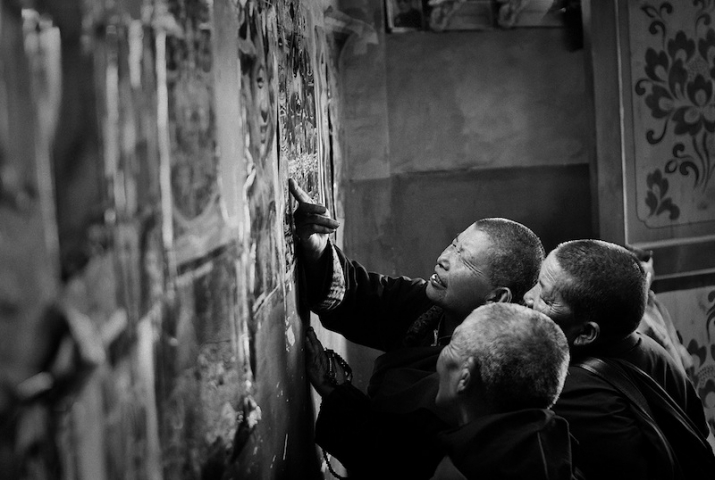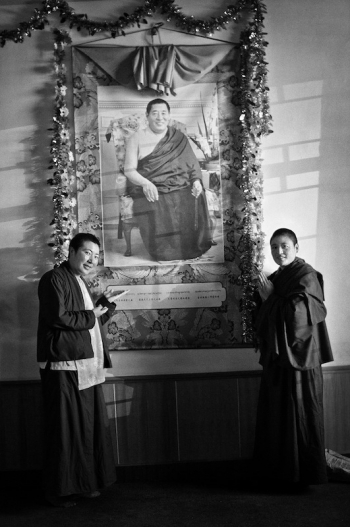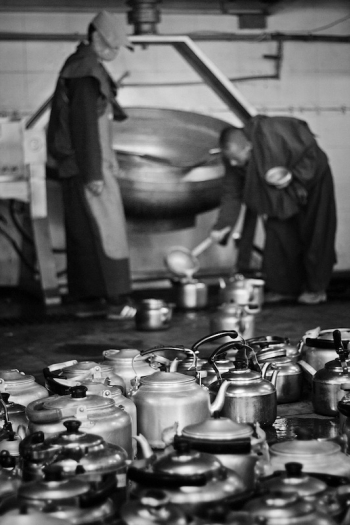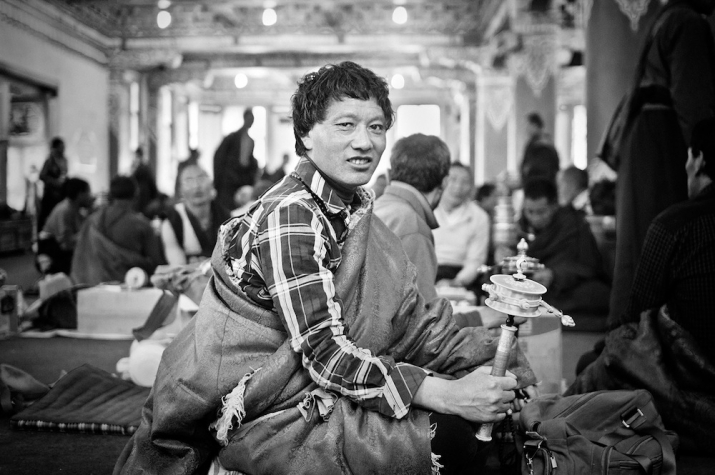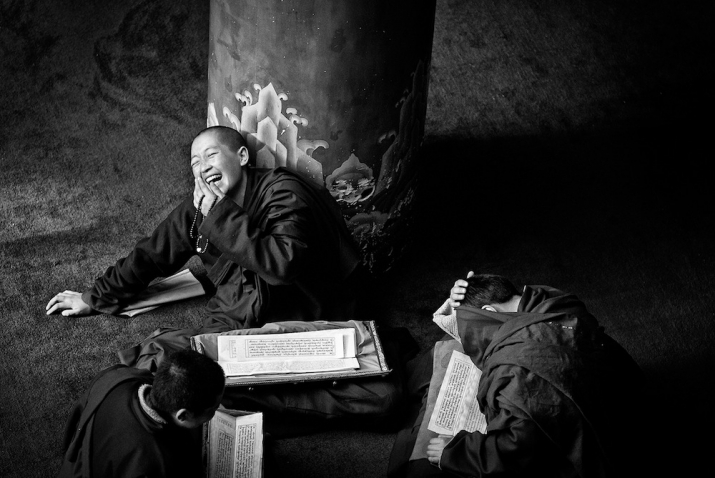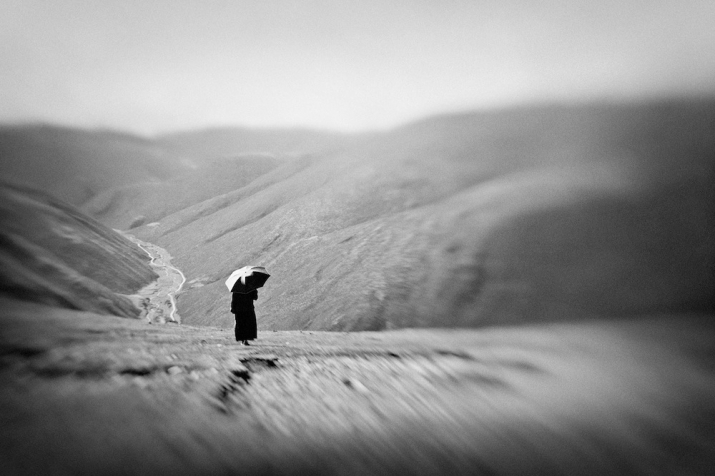The Wonders of Kham and Larung Gar, Part Two
By Victoria Knobloch
Buddhistdoor Global
| 2015-08-28 | Last spring, Victoria traveled overland from Chengdu to Larung Gar Buddhist Institutue in the traditional Tibetan region of Kham. Part One* of her account describes the stops she made en route, in Kangding and Ganzi. In Part Two, she continues on to Larung Gar.
Upon arriving at Larung Gar Buddhist Institute, I was immediately struck by its physical immensity. Surrounding the temples and main buildings are thousands of wooden bungalows built to accommodate the monks and nuns who study here. One red wooden hut after another crowds the side of the valley, embedded in the expansive green landscape.
When Khenpo Jigme Phuntsok (1933–2004) founded Larung Gar Buddhist Institute in 1980, the site was chosen because of its historical connection to the Vajrayana tradition. It is said that His Holiness the first Dudjom Rinpoche, Dudjom Lingpa (1835–1904), stayed here with his 13 disciples, all of whom attained “rainbow body”—a body of pure light, indicating their high realization.
Khenpo Jigme Phuntsok was recognized at the age of two as the reincarnation of Tertön Sogyal, Lerab Lingpa (1856–1926) of the Nyingma school of Tibetan Buddhism, who was a teacher of the 13th Dalai Lama. Conceived as an independent center of study, the institute was designed specifically to help revive the study and practice of Tibetan Buddhism following the impact of China’s Cultural Revolution (1966–76) and to revitalize the Dharma for the benefit of sentient beings. While it initially had fewer than 100 students, this number increased significantly over the next 20 years to 8,800 monks and nuns.
Seeking tighter control over religious activity in Tibet, however, in 1998 the Chinese government limited the number of residents at the institute to 1,400 (1,000 monks and 400 nuns), requiring most of the inhabitants to return to their hometowns. Beijing made Khenpo Jigme Phuntsok responsible for the institute’s growing population and asked him to expel some of the students; however Khenpo insisted that it would be inappropriate to evict the students as they were there purely for the study of Buddhism.
Today more than 10,000 monks and nuns live at the institute, making it the largest Buddhist academy of its kind in the world, and the number is still growing. Perhaps the institute’s most renowned alumnus is Tibetan Buddhist scholar Khenpo Sodargye Rinpoche, who was born in 1962.
One part of the institute is Pema Khandro Duling Nunnery, home to 3,500–4,000 nuns from all over Tibet. Here nuns may study for the khenpo degree—a doctoral degree in divinity—which has only just become possible for female monastics.
The curriculum at Larung Gar is divided into three main areas: Sutrayana, Mantrayana, and culture, which includes the study of linguistics, medicine, and the Tibetan language. The main courses in Sutrayana fall into five categories: Vinaya, the regulatory framework of the monastic sangha; Hetuvidya, a system of Buddhist logic; Abhidharmakosha-Shastra, a key text on the Abhidharma; Madhyamika, a school of Buddhist philosophy; and Prajnaparamita, the direct realization of the non-conceptual simplicity of all phenomena. Mantrayana consists of shastra, or commentaries on scriptures and sutras; preliminary practices, used to clear the mind of obscurations and karmic imprints; deity practice, in which the practitioner focuses on and identifies with the Buddha-form, which is represented by a deity; the Great Perfection, training for realizing and maintaining the natural primordial state; and Pith Instructions, condensed oral instruction passed directly from masters to students.
Personally, I feel that access to quiet and solitude is also essential for spiritual growth, though of course such luxuries are completely lacking within such a large community. Nevertheless, if quietude is needed, the monks and nuns can simply head out into the almost endless hilly expanse surrounding the institute. Indeed, while hiking in the area I saw many monks in the green hills doing solitary practice, although such opportunities must only be available during the spring and summer months since the winters at Larung Gar are long and bitter, with temperatures falling as low as –20 degrees centigrade.
Despite its size, the institute is still not featured on maps, yet it is such an impressive manifestation of devotion, practice, and education that it must surely be one of the wonders of the modern world. I was moved to have the privilege of seeing so many people studying the Dharma in one place. May this effort and its blessings be of benefit and inspiration to the world and to human development overall.
Victoria Knobloch is a member of Dharma Eye–The Buddhist Photographer collective. To learn more about Dharma Eye and Victoria’s work as a photographer, visit Dharma Eye.
*The Wonders of Kham and Larung Gar (Buddhistdoor Global)
See more
Introduction to Larung Gar Five Sciences Buddhist Academy (Khenpo Sodargye Rinpoche)

